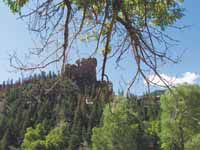| The Wilcox acquisition in Range Creek has many breathtaking views. |
The media descended with a fury upon Range Creek on Wednesday. An article in the Emery County Progress on June 15 entitled “A Hidden Treasure,” has attracted national attention. Kevin Jones, state archaeologist, contacted the Progress about a media tour to Range Creek to explain the area from the archaeological viewpoint. He said he was inviting five press organizations, including the Sun Advocate, Salt Lake Tribune, Deseret Morning News and one Associated Press reporter and the Progress.
Things seem to have gone awry as more than 50 press organizations including national reporters from the New York Times, Los Angeles Times, Denver Post, Chicago, Today Show, Utah State News organizations Fox 13, Channel 5, Channel 2, Channel 4, and many others attended the media event.
Also attending the event was Waldo Wilcox, former owner of the ranch. He said, “I think it is a mistake to bring the news media in here. There’s no way they will be able to protect it.”
The Wilcox family has protected the ranch for 50 years. The property was gated and trespassers weren’t welcome. The remoteness of the ranch and its inaccessibility does not lend itself to an occasional visit from a passerby. Currently access to the ranch can only be gained on foot or horseback
“I want them to keep it the way it was when I first came here. I am going to live in Green River for now and am maybe looking to buy a ranch in another state. My Dad taught us to take care of things and to leave things like we found them,” said Wilcox. He said it was hard to leave the ranch and sell out, but he is now 74 years old and it’s time to move on. “It was hard to leave, it is still hard to leave. I lived here a lot of the time alone, especially during the winter when the kids went to school in Green River. I knew there were enough artifacts and stuff here that if anyone found out about it, they probably would have condemned it and taken it away. But now, with the drought and everything, we are better off selling it. During my years here, I didn’t have time to to look for archaeological items, I knew I had to take care of the cows or I wouldn’t eat. My Dad instilled in us to leave everything as it was. Once when my Dad was younger he carved his initials in a rock and years later when I asked him about it, he said he was sorry he had done it.
| Waldo Wilcox stands within one of the many ancient pit houses. |
“Over the years we have kept the media out of here. Once a reporter from the Sun Advocate wanted to come and see it, and I said to come ahead, but to leave your camera home. I hope people can still see it and still protect it. If they can come and look, that’s great.”
Wilcox was questioned about the way of life of the Indians. He said they had a pretty rough life. When his grandfather was there and the Utes were living there. They would burn caterpillars and store them to eat during the winter. Wilcox said he believed the granaries on the property were also used to store the seed for the coming planting season as well as for food storage.
Wilcox said in the time he spent living on the ranch he never dug up an Indian grave or disturbed anything. He said a lot of people have told him they buried treasures with their people, but he said the people here were so poor, he didn’t think they did that because the dead were headed for the Happy Hunting Ground and the living people needed everything they had to sustain them in their existence.
“Living here was heaven on earth,” said Wilcox.
This is the first in a series of articles dealing with the Wilcox acquisition and its future.

